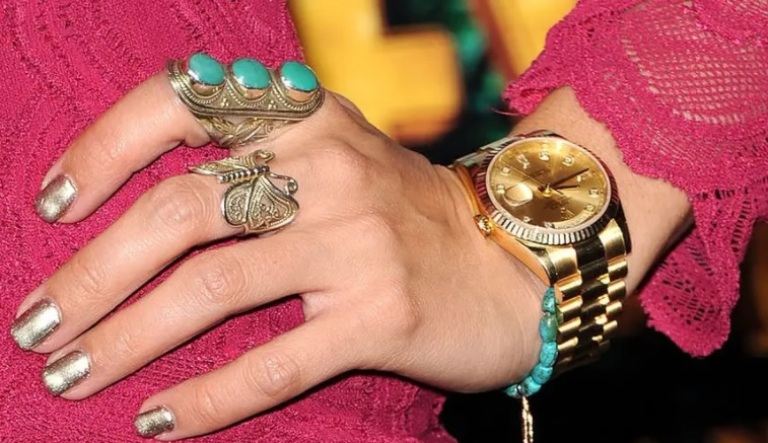
The sporty Rolex Milgauss version with a blue dial is on fire, too, with secondhand prices on the site spiking to $14,500, from $8,200 a year ago. COURTESY
A year ago, previously owned 18-karat-gold Rolex CosmographDaytonas with a green dial — nicknamed the “John Mayer” by aficionados, in honour of the guitar-wielding watch geek who helped make it a celebrity must-have — were selling for $52,000 on the Hodinkee Shop, a prominent online retailer of fine watches. This month, the same model went for $96,000.
The sporty Rolex Milgauss version with a blue dial is on fire, too, with secondhand prices on the site spiking to $14,500, from $8,200 a year ago. Ditto the Explorer II model, which has nearly doubled, to $13,000, from about $7,500 over the same period.
Another sign of runaway inflation? Not exactly.
“It’s Economics 101,” said Rob Corder, editor of WatchPro, an industry magazine in London. “If demand gets ahead of supply, prices are just going to go up and up.”
“The demand is absolutely off the scale,” Corder added. “I knew dealers who were saying three years ago that they had never seen demand for Rolex like this, but every year the market gets hotter and hotter.”
As a result, the prices for used Rolexes are booming, with the most sought-after models spiking on the secondary market like a hyped new cryptocurrency.
Demand is such that many shoppers who wander into authorised dealers often find few if any new Rolexes for sale (particularly the sport models), since dealers usually set aside their supply for favored customers.
“Historically, part of the charm of Rolex was that one could walk into any authorised dealer around the world with a few thousand dollars and walk out with a certifiable icon of modern watchmaking,” said Benjamin Clymer, the Hodinkee founder.
As recently as 2018, the Daytona was the only model that was hardly ever seen in shop windows, Clymer said. “Then, Submariners started to disappear,” he said. “Then GMT-Masters and Sea-Dwellers. Then Explorers, Air-Kings and even Sky-Dwellers and steel Datejusts.”
The scarcity grew so pronounced by last fall that Rolex made a rare public statement for an article in Yahoo Finance. “The scarcity of our products is not a strategy on our part,” the statement read. “Current production cannot meet the existing demand in an exhaustive way, at least not without reducing the quality of our watches.”
This is hardly to say Rolex is not moving product. The company made an estimated 1.05 million watches in 2021, according to a recent report by Morgan Stanley in collaboration with a Geneva-based firm, LuxeConsult, giving it an estimated 29% of the luxury Swiss watch market. By comparison, Patek Philippe produces about 60,000 timepieces a year. (Rolex, a private company, does not routinely disclose sales or production figures.)
So that is the supply part of the equation. Why the insatiable demand?
It seems that the pandemic helped turbocharge the market, said Steven Kaiser, president and CEO of Kennedy USA, a watch chain based in Australia.
“The biggest competitors to our industry were not other brands, but other luxuries like travel, entertainment, going to restaurants and Broadway shows,” Kaiser said. “You didn’t do those things for two years, so our industry was booming.”
Eye-popping auctions fueled the surge, too, Corder said. Once confined to tweedy insiders, watch auctions became a spectator sport in 2017 when Paul Newman’s Rolex Daytona — perhaps the most famous wristwatch in the world — sold for $15.5 million at a Phillips auction and generated countless headlines.
The booming watch market is not confined to Rolex. Prices have ballooned for several models of AudemarsPiguet’s Royal Oak line, favoured by celebrities like Drake, Justin Bieber and Stephen Curry, said Paul Altieri, founder of Bob’s Watches in Newport Beach, California. Exploding prices for the coveted, and recently discontinued, Model 5711 of the Patek Philippe Nautilus have drawn comparisons among some in the watch world to the Dutch tulip mania of the 17th century.
Others are most likely snapping up sought-after timepieces simply because rising prices make them seem like an attractive momentum play as an investment, at least for the moment. In recent years, many watch enthusiasts have come to view fine watches as an alternative asset class, a hedge against a wobbly market for stocks, bonds and cryptocurrencies.
Any of these investments — maybe all of them — may qualify as a bubble. A bubble can pop in uncertain times, either because of a pandemic or the Russia-Ukraine war. (Rolex was one of several Swiss watchmakers that stopped shipping to the Russian market since Russia invaded, even before the European Union banned luxury exports to Russia.)
At times of crisis, however, investors often flock to safe-haven currencies, like gold, which also rose at the start of the Russian invasion. And a Rolex does have certain advantages.
“The thing is,” Altieri said, “you can’t wear a gold bar on your wrist.”






0 Comments